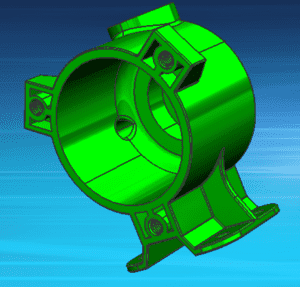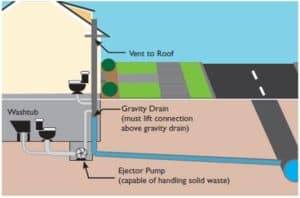Sewage Ejector Pump
Everyone wants to make their home a haven where everything works seamlessly and correctly. A sewer system is an essential infrastructure used to carry away wastewater, such as human waste, kitchen waste, and groundwater to keep our homes clean, safe, and disease-free. Often, most home sewer lines leverage gravity to channel wastewater into public sewer systems. Nonetheless, in cases where plumbing fixtures are placed below the primary sewer line level, gravity may not be useful thus a pumping system is required. In such cases, sewage ejector pumps are installed to lift wastewater from basement washrooms to a private septic tank or urban/municipal sewer system.

What’s a Sewage Ejector Pump?
Also known as a pump-up ejector system, a sewage ejector pump is a submersible piece of equipment that is installed inside a sewage basin often found in the lower part of a building. Its main role is to lift “soft” solid and liquid wastes up to a communal sewer system in commercial or residential setups. Simply put, sewage ejector pumps help remove wastewater in cases where gravity alone is unable to do so. Often, sewage ejector pumps are used in homes with basement washrooms and laundry rooms.

Figure: Working of a sewage ejector pump
Types of Sewage Ejector Pumps
There are different types of sewage ejector pumps based on style, and manufacturers are adopting different designs and materials to develop them. However, irrespective of the vast variety of these pumping systems, they are classified into three main groups, including submersible pumps, self-priming pumps, and vertical pumps.
- Submersible ejector pumps
As the name suggests, these types of sewage ejector pumps are completely submerged inside a sump basin. They are the most prevalent types of pumps available. Submersible pumps come in two types: single-seal design and double-seal design, with the latter being a bit more robust for a system that kicks on throughout the day, without “straining.” Some submersible pumps feature a grinding mechanism to help reduce the size of the solid materials further.
- Self-priming ejector pumps
Self-priming sewer ejector pumps are used where there is no adequate headroom inside the sump basin. Instead of being immersed inside the pit, they are installed atop it and filled with water, hence the name “self-priming.” Compared to submersible pumps, self-priming sewage ejector pumps are easier to uninstall for service maintenance and cleaning. These pumps are designed for shallower pits.
- Vertical ejector pumps.
This is perhaps the oldest technology of sewer ejector pumps. While vertical ejector pumps have been largely out-fashioned by the aforementioned two ejector pump styles, they are long-lasting and they are mostly found in older homes. These systems come with a motor that rests on a plate and a pump shaft along with a discharge pipe that is both immersed inside the pit. The larger part of the pump is not immersed in the wastewater and thus requires frequent lubrication. Unlike the submersible and self-priming ejector pumps, vertical pumps are suitable for less regular use.
How does it work?
Essentially, a sewer ejector pump is a simple piece of equipment that consists of a pump system that sits inside a sump basin and an attached float system. When the wastewater level in the sump tank increases, it raises the float that in turn engages the motor. The motor pumps solid and liquid materials from the basin and channels them to the primary sewer system located outside the building.
As wastewater is emptied from the basin, the float returns down and signals the motor to switch off once the minimum level of sewage in the basin is reached, and the cycle goes on.
Significance of sewer ejector pumps
- Flexible
Perhaps the main benefit that a homeowner enjoys from a sewer ejector pump is the vast level of flexibility it offers. Homes that are located at lower elevations than the primary sewer lines or have washrooms in the basement of the property have no other option than installing a sewer ejector pump. Ejector pumps can also be installed if the homeowner feels that gravity is not sufficient to remove wastewater from their house.
- Efficient
Compared to other solid and liquid waste pumping systems, sewer ejector pumps are relatively efficient. Also, they can be used to flush wastewater where water pressure is low – often caused by slight blockage.
- Cost-effective
Some people think/say that installing and maintaining a sewer ejector pump is costly, but experts consider the argument as a myth. Actually, the opposite is true. Installing and maintaining these types of pumping systems is relatively cheap. In addition, the homeowner saves money as these systems require minimal servicing, implying sewer ejector pumps are worth the investment.
- Minimized risks
Sewer ejector pumps flush solid and liquid wastes from homes, which minimizes the risk of the accumulation of harmful wastes and awful odors inside the property.
Where is it installed?
Sump basins are usually placed underground below the basement floor with an ejector pump sitting inside it. The pump pushes the fluids that accumulate in the basin up into a septic tank or main sewer line.
Maintenance
Most sewer ejector pumps require minimal maintenance, often performed by a professional plumber. During maintenance, the technician removes the pump from the sump basin, cleans it, lubricates the motor and other moving parts, and conducts a complete inspection of the machine, electrical parts, and the float. Also, they clean the sump basin and remove all debris accumulated inside.
Homeowners too have a role to play to ensure that the pump works efficiently. They should avoid dropping solid objects into the toilet bowl and only use toilet paper when helping themselves. Other materials can obstruct the machine making it strain to force them out. Undoubtedly, the service time of the pump will be compromised and this could also result in sewage overflow and bad odors inside your house.
Final thoughts
A sewer ejector pump plays a critical role in the home plumbing system to ensure efficient waste removal, making it a superb addition to your home. Its installation comes with various benefits for property owners. Arguably, a sewer ejector pump ensures that you live in a clean and safe environment.
